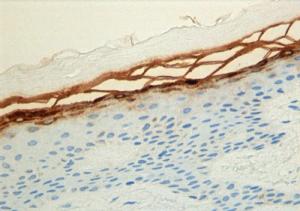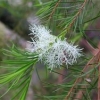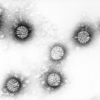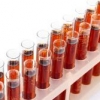Correlazioni tra il cancro e le mutazioni con perdita di funzione della filaggrina
 Uno studio di popolazione
Uno studio di popolazione
Le mutazioni con perdita di funzione del gene della filaggrina (FLG) potrebbero avere effetti opposti sul rischio di cancro, dal momento che le mutazioni sono associate sia ad un aumento del 10% dei livelli sierici di vitamina D — che potrebbe essere un fattore protettivo contro il cancro — sia ad un'alterazione della funzione di barriera cutanea — che potrebbe portare ad una maggiore suscettibilità al cancro stesso.
Obiettivi
Abbiamo studiato l'associazione tra genotipo di FLG e i tipi specifici di tumori in quattro coorti.
Metodi
Sono stati inclusi nello studio 13,376 individui che, successivamente, sono stati genotipizzati per la ricerca di mutazioni selezionate di FLG comuni tra i soggetti nord europei. Inoltre, sono state ottenute le informazioni sul cancro dal Registro Danese dei Tumori, fino all'11 luglio 2011. Le persone con una storia di cancro al basale sono state escluse dalle analisi prospettiche.
Risultati
Ci sono stati 1,339 casi di cancro (follow-up medio di 11.4 anni). Gli hazard ratio (HR) e gli intervalli di confidenza al 95%, (CIs al 95%) per i portatori di mutazioni di FLG rispetto ai genotipi wild-type, sono stati: per qualsiasi tipo di cancro (HR=0.95, CI al 95%: 0.78, 1.16), per tutti i cancri eccetto il tumore cutaneo non-melanoma (TCNM) (HR=1.05, CI al 95%: 0.84, 1.31), per il tumore della testa e del collo (HR=1.72, CI al 95%: 0.71, 4.15), per il tumore del colon-retto (HR=0.82, CI al 95%: 0.44, 1.52), per il il cancro dei bronchi e del polmone (HR=1.34, CI al 95%: 0.77, 2.33), per il tumore al seno (HR=0.58, CI al 95%: 0.30, 1.14), per il cancro dell'utero (HR=0.42, CI al 95%: 0.06, 3.10), per il tumore della prostata (HR=1.09, CI al 95%: 0.61, 1.94), per il cancro delle vie urinarie (HR=1.30, CI al 95%: 0.51, 3.29), per il melanoma maligno (HR=1.03, CI al 95%: 0.41, 2.58) e per il TCNM (HR=0.70, CI al 95%: 0.47, 1.05). Al basale e nelle analisi di sottogruppo tra i partecipanti di età superiore ai 60 anni, sono stati trovati dei rischi più bassi (statisticamente significativi) per tutti i tumori e per il TCNM tra i portatori della mutazione di FLG.
Conclusioni
Tranne che nelle analisi di sottogruppo, non sono state osservate associazioni statisticamente significative tra le mutazioni con perdita di funzione della FLG e il cancro.
Storia della pubblicazione:
Titolo: Filaggrin loss-of-function mutations and incident cancer: A population-based study
Rivista: British Journal of Dermatology. doi: 10.1111/bjd.12969
Autori: T. Skaaby, L.L.N. Husemoen, J.P. Thyssen, M. Meldgaard, B.H. Thuesen, C. Pisinger, T. Jørgensen, K. Carlsen, J.D. Johansen, T. Menné, P.B. Szecsi, S. Stender e A. Linneberg
Affiliazioni:Research Centre for Prevention and Health, Glostrup University Hospital, Denmark National Allergy Research Centre, Department of Dermato-Allergology, Copenhagen University Hospital Gentofte, Hellerup, Denmark Department of Clinical Biochemistry, Copenhagen University Hospital Gentofte, Hellerup, Denmark Faculty of Health Science, University of Copenhagen, Denmark Faculty of Medicine, Alborg University, Denmark Department of Clinical Experimental Research, Glostrup University Hospital, Denmark Department of Clinical Medicine, Faculty of Health and Medical Sciences, University of Copenhagen, Denmark
Abstract:
Background Loss-of-function mutations in the filaggrin gene (FLG) could have opposing effects on cancer risk, since mutations are both associated with 10% higher serum vitamin D levels, which are possibly protective against cancer, and with impaired skin barrier function, which could lead to a higher cancer susceptibility. Objectives We investigated the association of the FLG genotype and specific types of cancers in four population-based cohorts. Methods A total of 13,376 individuals were included and genotyped for selected common FLG mutations in Northern Europeans. Information on cancer was obtained from The Danish Cancer Registry until 11 July 2011. Persons with a history of cancer at baseline were excluded from the prospective analyses. Results There were 1,339 incident cancers (median follow-up 11.4 years). The hazard ratios (HRs) and 95% confidence intervals, (95% CIs) for FLG mutation carriers vs. wild types were: for any cancer (HR=0.95, 95% CI: 0.78, 1.16), any cancer excluding non-melanoma skin cancer (NMSC) (HR=1.05, 95% CI: 0.84, 1.31), head and neck cancer (HR=1.72, 95% CI: 0.71, 4.15), colorectal cancer (HR=0.82, 95% CI: 0.44, 1.52), cancer of bronchus and lung (HR=1.34, 95% CI: 0.77, 2.33), breast cancer (HR=0.58, 95% CI: 0.30, 1.14), cancer of the uterus (HR=0.42, 95% CI: 0.06, 3.10), prostate cancer (HR=1.09, 95% CI: 0.61, 1.94), urinary cancer (HR=1.30, 95% CI: 0.51, 3.29), malignant melanoma (HR=1.03, 95% CI: 0.41, 2.58) and NMSC (HR=0.70, 95% CI: 0.47, 1.05). In subgroup analyses of the participants over the age of 60 years at baseline, we found statistically significant lower risks of all cancers and NMSC among FLG mutation carriers. Conclusions There were no statistically significant associations between FLG loss-of-function mutations and cancer except in subgroup analyses.





